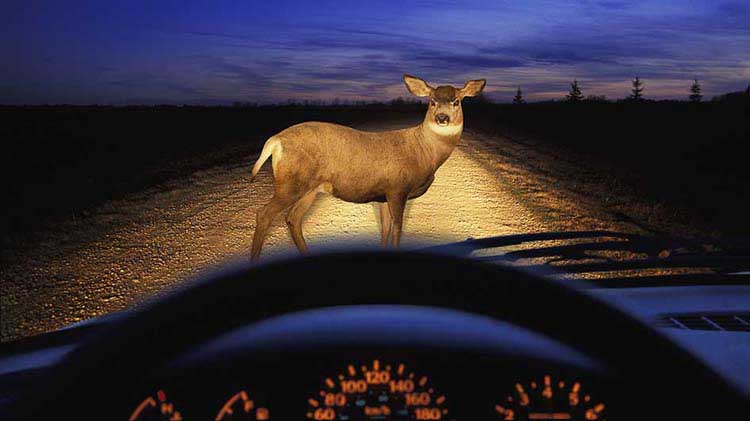To determine if a deer has been hit, look for signs like blood on the road, damage to your vehicle, tracks, and hair on your car. If you see any of these signs, it is likely that you hit a deer.
When driving, it is essential to be aware of deer crossings and their potential to run out onto the road unexpectedly. Driving in areas where deer are known to reside can be a picturesque experience, but it is also dangerous. Collisions with deer can result in injury to both the driver and the animal. It is important to be vigilant while driving on rural or suburban roads and to keep an eye out for potential danger. In this guide, we will explore the signs that indicate you have hit a deer, what to do if you hit one, and ways to prevent deer collisions.

Credit: www.statefarm.com
Contents
Understanding The Signs Of A Collision
Deer are common road hazards, especially in rural areas. Understanding the signs of a collision is important to determine the fate of the animal and ensure the safety of humans. Symptoms of a deer that has been hit by a vehicle include: blood or fur on the vehicle, broken bones, difficulty standing, limping or dragging a leg, and an injured appearance.
If a deer has been hit, it’s important to approach the animal with caution and contact local authorities or animal control for assistance. Leaving an injured deer on the road can cause further accidents and endanger other drivers. By recognizing the signs of a deer collision, we can reduce the number of deaths and injuries caused by these unexpected road obstacles.
Identifying The Location Of The Collision
After a collision with a deer, finding tracks and damage can help determine the animal’s condition. The first step is to search for deer tracks near the accident location. Look for hair or blood on nearby vegetation or on the vehicle that struck the deer.
If the accident occurred on a highway, contact local authorities for assistance. If the deer appears to be alive but injured, call a wildlife rehabilitation center. Only approach a live deer if it is safe to do so, keeping in mind that injured animals can be dangerous.
If it is clear that the deer did not survive the collision, it may be legally permissible to take the animal for food or other uses.
Assessing The Condition Of The Deer
Assessing the condition of a deer after a collision with a vehicle is essential. First, check for signs of life, such as breathing or a pulse. If the deer is alive, call a professional to provide medical assistance. Identify any injuries, such as broken bones or internal bleeding, by examining the deer’s body for wounds and swelling.
If the deer is dead, contact the authorities to ensure proper disposal and reduce the risk of spreading diseases. Remember to exercise caution when approaching an injured deer as they may be scared and may lash out, causing further harm to themselves or others.
Contacting The Proper Authorities
After hitting a deer while driving, one of the first things you need to do is contact the proper authorities. This includes the police, and possibly local animal control. Reporting the incident is necessary for documentation purposes and will aid in any insurance claims.
However, ensure that your safety and the safety of others is the top priority. Move your car to a safe spot if possible and remain in it until help arrives. Avoid approaching the animal, as it may still be alive and pose a danger.
Stay calm and follow the instructions provided by the authorities.
Preventing Vehicle-Deer Collisions
Deer are often active around dawn and dusk, and they tend to move around in groups. So, if you spot one deer, look out for others. If a deer is hit, there will be evidence left on the vehicle, such as fur, blood or damage to the car.
Understanding deer behavior and taking appropriate precautions can prevent vehicle-deer collisions. Drivers should slow down in areas where deer are known to be present and keep their headlights on high beam when driving at night. It’s important to always be alert and attentive while driving in areas where deer populations are known to be high.
By following these precautions, you can reduce the risk of hitting a deer and ensure a safe driving experience for all.
Frequently Asked Questions On How Do You Tell If A Deer Is Hit?
Conclusion
Based on the signs and signals discussed in our blog post, it’s essential to know how to tell whether a deer is hit or not, and always exercise caution on the road to prevent accidents. Identifying the signs of an animal being hit, such as hair or blood on the vehicle or the road, or any physical damage to the animal, can help you know what to do next.
Making sure not to swerve or panic when you notice a deer on the road can make all the difference in avoiding a collision. Additionally, knowing how to handle the situation if you do hit a deer – such as calling for help and avoiding contact with the animal – can help ensure your safety and the animal’s wellbeing.
Overall, it’s crucial to stay vigilant and informed to avoid collisions and minimize harm to both yourself and the natural environment.

